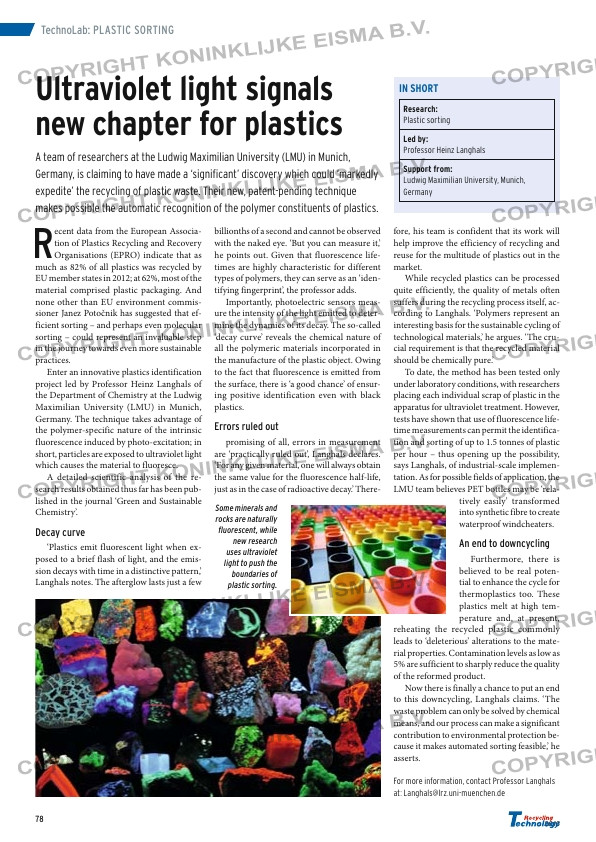Page 78 from: Recycling Technology 2016

2016
78
TechnoLab: PLASTIC SORTING
Ultraviolet light signals
new chapter for plastics
A team of researchers at the Ludwig Maximilian University (LMU) in Munich,
Germany, is claiming to have made a ‘significant’ discovery which could ‘markedly
expedite’ the recycling of plastic waste. Their new, patent-pending technique
makes possible the automatic recognition of the polymer constituents of plastics.
R
ecent data from the European Associa-
tion of Plastics Recycling and Recovery
Organisations (EPRO) indicate that as
much as 82% of all plastics was recycled by
EU member states in 2012; at 62%, most of the
material comprised plastic packaging. And
none other than EU environment commis-
sioner Janez Potočnik has suggested that ef-
ficient sorting – and perhaps even molecular
sorting – could represent an invaluable step
in the journey towards even more sustainable
practices.
Enter an innovative plastics identification
project led by Professor Heinz Langhals of
the Department of Chemistry at the Ludwig
Maximilian University (LMU) in Munich,
Germany. The technique takes advantage of
the polymer-specific nature of the intrinsic
fluorescence induced by photo-excitation; in
short, particles are exposed to ultraviolet light
which causes the material to fluoresce.
A detailed scientific analysis of the re-
search results obtained thus far has been pub-
lished in the journal ‘Green and Sustainable
Chemistry’.
Decay curve
‘Plastics emit fluorescent light when ex-
posed to a brief flash of light, and the emis-
sion decays with time in a distinctive pattern,’
Langhals notes. The afterglow lasts just a few
billionths of a second and cannot be observed
with the naked eye. ‘But you can measure it,’
he points out. Given that fluorescence life-
times are highly characteristic for different
types of polymers, they can serve as an ‘iden-
tifying fingerprint’, the professor adds.
Importantly, photoelectric sensors meas-
ure the intensity of the light emitted to deter-
mine the dynamics of its decay. The so-called
‘decay curve’ reveals the chemical nature of
all the polymeric materials incorporated in
the manufacture of the plastic object. Owing
to the fact that fluorescence is emitted from
the surface, there is ‘a good chance’ of ensur-
ing positive identification even with black
plastics.
Errors ruled out
promising of all, errors in measurement
are ‘practically ruled out’, Langhals declares.
‘For any given material, one will always obtain
the same value for the fluorescence half-life,
just as in the case of radioactive decay.’ There-
fore, his team is confident that its work will
help improve the efficiency of recycling and
reuse for the multitude of plastics out in the
market.
While recycled plastics can be processed
quite efficiently, the quality of metals often
suffers during the recycling process itself, ac-
cording to Langhals. ‘Polymers represent an
interesting basis for the sustainable cycling of
technological materials,’ he argues. ‘The cru-
cial requirement is that the recycled material
should be chemically pure.’
To date, the method has been tested only
under laboratory conditions, with researchers
placing each individual scrap of plastic in the
apparatus for ultraviolet treatment. However,
tests have shown that use of fluorescence life-
time measurements can permit the identifica-
tion and sorting of up to 1.5 tonnes of plastic
per hour – thus opening up the possibility,
says Langhals, of industrial-scale implemen-
tation. As for possible fields of application, the
LMU team believes PET bottles may be ‘rela-
tively easily’ transformed
into synthetic fibre to create
waterproof windcheaters.
An end to downcycling
Furthermore, there is
believed to be real poten-
tial to enhance the cycle for
thermoplastics too. These
plastics melt at high tem-
perature and, at present,
reheating the recycled plastic commonly
leads to ‘deleterious’ alterations to the mate-
rial properties. Contamination levels as low as
5% are sufficient to sharply reduce the quality
of the reformed product.
Now there is finally a chance to put an end
to this downcycling, Langhals claims. ‘The
waste problem can only be solved by chemical
means, and our process can make a significant
contribution to environmental protection be-
cause it makes automated sorting feasible,’ he
asserts.
For more information, contact Professor Langhals
at: [email protected]
IN SHORT
Research:
Plastic sorting
Led by:
Professor Heinz Langhals
Support from:
Ludwig Maximilian University, Munich,
Germany
Some minerals and
rocks are naturally
fluorescent, while
new research
uses ultraviolet
light to push the
boundaries of
plastic sorting.



